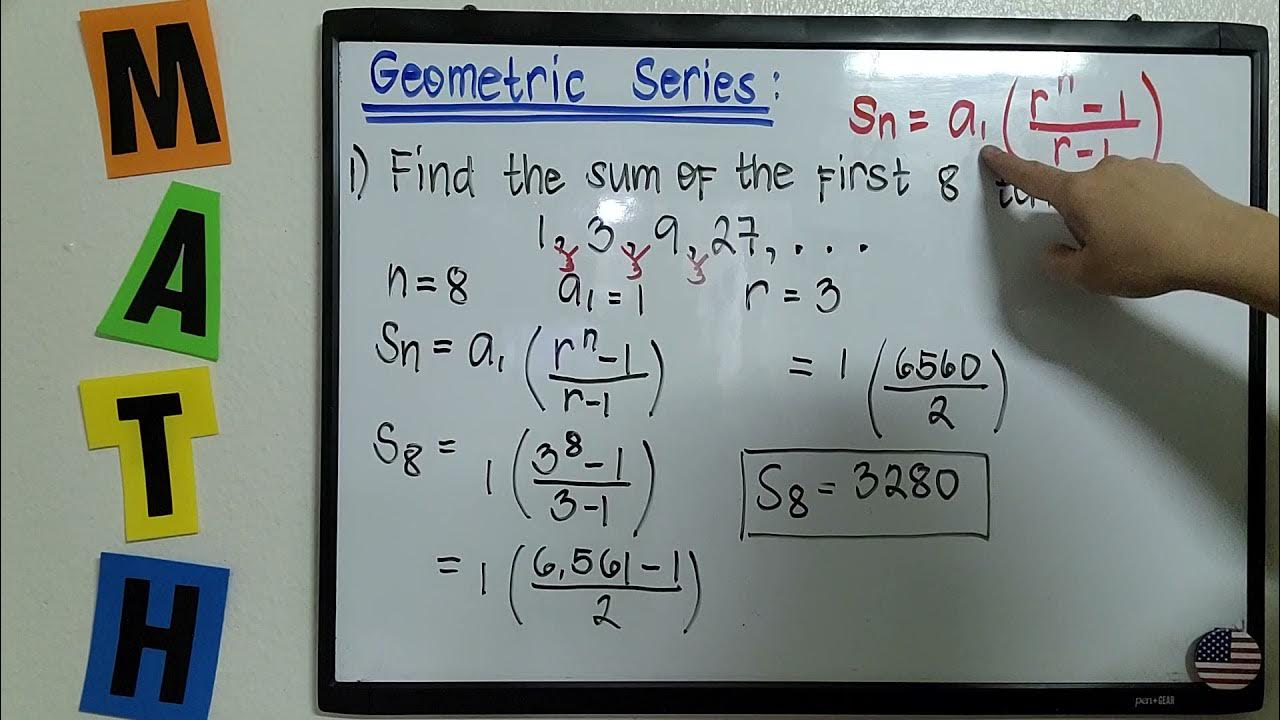Sequences and series (part 2)
Summary
TLDRThis educational video script explores the concept of geometric series, demonstrating how to calculate their sum using the formula S = (a^{n+1} - 1) / (a - 1). It illustrates the process with examples, including the intriguing scenario where the sum of an infinite geometric series with a base of 1/2 converges to 2. The script effectively conveys the beauty of mathematics by showing how an infinite series can result in a finite, calculable sum.
Takeaways
- 🧮 The video continues from where the previous one left off, discussing the geometric series.
- 🔢 A geometric series involves summing terms of the form 'a^k' where 'a' is a constant and 'k' is the exponent.
- 🧠 The speaker defines the geometric sum (S) and introduces another sum (a * S) to help simplify the calculation.
- ➖ Subtracting the second sum (a * S) from the first sum (S) leads to the cancellation of many terms, simplifying the expression.
- ✏️ The resulting formula for the sum of a geometric series is S = (a^(n+1) - 1) / (a - 1).
- 🔍 The formula is useful for calculating the sum of finite geometric series, such as summing powers of 3 up to 3^10.
- ♾️ The speaker transitions to discussing infinite geometric series, which converge if the base 'a' is less than 1.
- ⚖️ When the base 'a' is a fraction (like 1/2), the terms get smaller and smaller as the series progresses.
- 🔗 The formula can also be applied to infinite series, and as n approaches infinity, the sum converges to a finite number.
- 🎯 A specific example is given: the sum of 1/2, 1/4, 1/8, etc., converges to the value 2.
Q & A
What is a geometric series?
-A geometric series is a sequence of numbers where each term after the first is found by multiplying the previous one by a fixed, non-zero number called the common ratio.
What is the sum of a geometric series with the first term 'a' and the last term 'a^n'?
-The sum S of a geometric series from a^0 to a^n can be calculated using the formula S = a^(n+1) - 1 / (a - 1), provided that the common ratio 'a' is not equal to 1.
Why did the presenter correct 'a^(n-2)' to 'a^n' in the script?
-The presenter corrected 'a^(n-2)' to 'a^n' because the original notation was incorrect. The series should include terms up to 'a' raised to the power of 'n', not 'n-2'.
How does the presenter define the sum 's' in the script?
-The presenter defines 's' as the sum of a geometric series, which is the sum of terms from 'a^0' to 'a^n'.
What is the purpose of defining another sum 'a*s' in the script?
-Defining 'a*s' allows the presenter to create an equation that, when simplified, helps derive the formula for the sum of a geometric series.
What happens when the presenter subtracts 's' from 'a*s' in the script?
-When 's' is subtracted from 'a*s', all terms except the first ('a^0') and the last ('a^(n+1)') cancel out, leaving 'a^(n+1) - 1'.
Why does the presenter multiply the top and bottom of the fraction by -1 in the script?
-The presenter multiplies the top and bottom by -1 to simplify the fraction and make it easier to understand that the sum of an infinite geometric series with a ratio of 1/2 is 2.
What is the significance of the presenter's question about subtracting 's' from 'a*s'?
-This question is significant because it leads to the discovery that the sum of a geometric series can be represented by a simple formula, which is crucial for understanding the properties of geometric series.
How does the presenter demonstrate the concept of an infinite geometric series?
-The presenter demonstrates an infinite geometric series by considering a series with a common ratio of 1/2 and showing that the sum converges to a finite number (2) as the number of terms approaches infinity.
What does the presenter suggest as a project to further understand geometric series?
-The presenter suggests drawing out an infinite geometric series as a pie chart to visualize how adding smaller and smaller pieces results in a finite sum.
Why is the sum of an infinite geometric series with a ratio of 1/2 equal to 2?
-The sum equals 2 because as the number of terms approaches infinity, the terms become infinitesimally small and approach zero, leaving only the first term 'a^0' which is 1, and the last term 'a^(n+1)' which approaches 1, resulting in the sum being 1/(1 - 1/2) = 2.
Outlines

Dieser Bereich ist nur für Premium-Benutzer verfügbar. Bitte führen Sie ein Upgrade durch, um auf diesen Abschnitt zuzugreifen.
Upgrade durchführenMindmap

Dieser Bereich ist nur für Premium-Benutzer verfügbar. Bitte führen Sie ein Upgrade durch, um auf diesen Abschnitt zuzugreifen.
Upgrade durchführenKeywords

Dieser Bereich ist nur für Premium-Benutzer verfügbar. Bitte führen Sie ein Upgrade durch, um auf diesen Abschnitt zuzugreifen.
Upgrade durchführenHighlights

Dieser Bereich ist nur für Premium-Benutzer verfügbar. Bitte führen Sie ein Upgrade durch, um auf diesen Abschnitt zuzugreifen.
Upgrade durchführenTranscripts

Dieser Bereich ist nur für Premium-Benutzer verfügbar. Bitte führen Sie ein Upgrade durch, um auf diesen Abschnitt zuzugreifen.
Upgrade durchführenWeitere ähnliche Videos ansehen
5.0 / 5 (0 votes)






